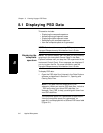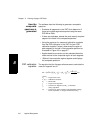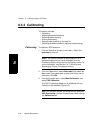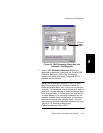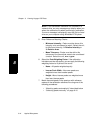
Chapter 8 Viewing Voyager PSD Data
8-10 Applied Biosystems
8
8.3 Calibrating a PSD Spectrum
NOTE: Multi-point calibration yields higher mass accuracy
than one-point calibration.
This section includes:
• Checking peak detection
• Calibrating
• Creating PSD .CAL files and applying to other data files
• Creating PSD calibration reference (.REF) files
• Changing the precursor mass
When to use this
procedure
Use this procedure to:
• Generate a PSD calibration (.CAL) file from a known
standard analyzed in PSD mode. You can then export the
PSD .CAL file and include the PSD .CAL file in a PSD
instrument settings (.BIC) file you use to acquire unknown
PSD samples.
• Internally calibrate an unknown PSD data file by
specifying known monoamino acid fragment ions as the
peaks to match during calibration.
Overview of
creating a PSD
.CAL file
To create a PSD .CAL file:
• Acquire a peptide standard with a known sequence in
PSD mode.
• Check peak detection as described in Section 8.3.1,
Checking Peak Detection.
• Create a calibration reference (.REF) file as described in
Section 8.3.4, Creating PSD
Calibration Reference (.REF) Files.
• Internally calibrate the PSD .DAT file as described in
Section 8.3.2, Calibrating. Specify the calibration
reference (.REF) file created in Section 8.3.4, Creating
PSD Calibration Reference (.REF) Files, when
calibrating.
• Export the calibration (.CAL) file from the PSD .DAT file to
use when acquiring unknown samples in PSD mode.



